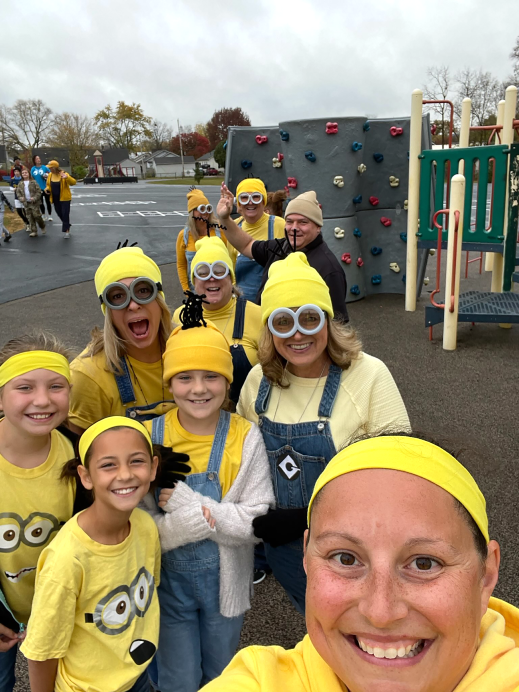Building and Communicating Your Internal Personal Brand
Your personal leadership brand impacts your schools at every level. But how are you communicating it to teachers and staff?

Think back to your first job right out of college. Whether you started in education or another field, chances are you still remember exactly who your first boss was—their demeanor, their leadership style, the way they handled stressful situations. It’s impossible to work for someone and not walk away with a lasting impression of their values and motivations. If your boss talked down to you when you needed support, you’ll always remember both how it made you feel and how it affected your work. But if they heard you out and provided the support you needed, you’ll remember that, too—and you’ll remember how it impacted your buy-in and willingness to trust their decisions.
In school leadership, there may be nothing so important as building a personal brand that is clear and consistent. We know that can mean different things to different people—but suffice it to say we’re not talking about social media or influencer-style personas here. When we talk about building your personal brand, we mean it in the deepest sense of the term.
Personal branding, as we define it, is the intentional story you’re telling about yourself, built around your core values and acting as a guidepost for your leadership. To put it even more simply: Your personal brand is who you are and how you lead. The better your stakeholders know you, the more they will trust you and support your leadership.
At SchoolCEO, we’ve discussed personal branding in the past, focusing our attention on how you’re sharing that brand with your broader community. But how are you communicating your personal brand to your staff? How does your team see you as a person and leader? If we asked a teacher in your district to describe your leadership style, what would they tell us?
There’s no doubt that who you are as a leader deeply impacts the success of your schools. In fact, our 2023 research study “What Teachers Want” found that school leadership is one of the top three factors teachers consider when applying for jobs. But internal personal branding isn’t just about knowing who you are; it’s about knowing how to share that with everyone working in your district. By successfully building and communicating your personal brand internally, you can inspire your staff’s best work and instill a culture of trust that permeates your schools at every level.
Take Out the Guesswork
Just as it is with your district brand as a whole, if you’re not telling your own story, someone will tell it for you. Your staff shouldn’t have to do any guesswork; they should know exactly who you are and how you approach your work. Gone are the days when being aloof and unapproachable were accepted styles of leadership. Today, when it comes to winning the buy-in you need to run a successful district, transparency reigns supreme.
Be vulnerable.
We know, we know—words like “vulnerable” often trigger skepticism these days. It’s easy to be suspicious of terms like this when they start being tossed around in the zeitgeist without sincerity or follow-through. But the true power of vulnerability—especially for school leaders—simply can’t be ignored. Committing to vulnerability in a thoughtful and intentional way can supercharge your relationships with staff and help create a culture that thrives under any circumstance. But what does thoughtful, authentic vulnerability really look like in practice?
Researcher and storyteller Brené Brown says “Vulnerability is the birthplace of love, belonging, joy, courage, empathy, and creativity.” We don’t have to tell you that these are all essential to sustaining a student-centered culture—so your internal personal brand should be centered around expressing these qualities in your everyday, observable work as a leader. But how do you do that? It’s simple, but not always easy: Be your whole self.
It’s all about making sure you’re showing authenticity and nuance, joy and struggle. The more your employees can relate to you, the more they’ll support and be inspired by you. Writing for Fast Company, leadership communication consultant Deborah Grayson Riegel advises, “Share information about your life outside of work. Let people know what you wrestle with, as well as what you celebrate, personally and professionally.”
It’s not necessary to overshare your private life with employees, but relating to them on a human level helps them see you as a whole person, not just as someone who sits behind a big desk and makes big decisions. So confide in that new teacher about a struggle you had in your first classroom. High-five that food service worker when their favorite team wins the big game. Tell that bus driver who’s a new homeowner about your experience buying your first house. The more you show them who you are, the more they’ll trust you to steer them in the right direction.
Model your values.
An integral part of building your personal brand internally is making sure the values you tout are actually motivating your behavior. It’s not enough to tell your teachers and staff who you are; you have to show them.
“Actions really do speak louder than words,” says Dr. Laura Blessing, superintendent of Ohio’s Miamisburg City Schools. She describes her internal personal brand as energetic, down-to-earth, and focused on students first. But it’s hard to make sure everyone sees that without a little intentionality. “We have about 700 staff members in our district, and I can’t have a personal connection with every single one,” she says. “But I still want them to know what I’m about—so I’ve got to model that through my leadership style.”
One way Blessing does this is by serving her school community in any capacity she can. “I’ve been a substitute teacher, served in cafeterias, helped at sporting events, and I volunteer in the community,” she tells us. “I think when they see me, they know that I’m not just there to make an appearance. I’m there to be a part of the experience for our students and the community. I serve 24/7—and it doesn’t bother me. That’s just the all-in commitment that a school leader has to have in 2023.”

Build Relationships to Foster Trust
According to Marcel Schwantes, leadership coach and host of the Love in Action podcast, trust is the backbone of successful leadership. “Employees and leaders who trust one another learn to be comfortable being open to one another about their failures, weaknesses, disappointments and even fears,” Schwantes says. A staff that isn’t afraid to ask you for help or express their concerns, that trusts you to always be honest and supportive, will follow you anywhere.
But what do we really mean when we say “trust”—and how do you go about showing your internal stakeholders that you’re worthy of theirs?
Dr. Andrew Dolloff, author of the book The Trust Imperative, is in his 10th year as superintendent of Yarmouth School Department in Maine. He defines trust as “the confidence or belief others have in your reliability, integrity, and competence.” Maintaining trust internally, then, starts and ends with how your employees perceive you as a leader—so communicating an internal personal brand that encourages this kind of trust is extremely important. We believe the best way to embody that brand is by building relationships with your staff and teachers.
Make time for teachers and staff.
Showing up has a huge impact on your employees. When you make time for your teachers and staff, you foster the kind of trusting relationships necessary for running great schools. And it shouldn’t just be scheduled or routine appearances. It could be sitting in on department meetings, attending a teacher’s retirement party, calling to congratulate a staff member on the birth of their child—you name it. If there’s an opportunity to be present for your staff, it’s well worth it.
Dr. John Sanville, superintendent of Unionville-Chadds Ford School District in Pennsylvania, says you don’t have to give away all your time or make enormous commitments to keep relationships strong. “It’s not about the grandeur of your interactions,” he says. “It’s the frequency. You have to do a lot of little things over time.” Sanville will often send a teacher an article that reminds him of a conversation they’ve had or message a staff member about their favorite band coming to town. “It doesn’t take a lot of time, but I have to listen to you. I have to understand what you find important to tend to that relationship,” he says.

Be approachable.
When it comes to branding yourself as a trustworthy leader, Blessing says one word comes to mind: approachability. Whether she’s at a staff meeting or visiting a classroom, she tries to make sure everyone in the district is comfortable when she walks in. In fact, Blessing makes it a priority to meet with all 13 teams at Miamisburg Middle School regularly, without their principal present. “I just sit down with them for 30 minutes, and I listen,” she says.
For Blessing, interactions like this communicate a clear personal brand of approachability and receptiveness, but also a willingness to be part of the work on the ground. “I do feel like all of them have a comfort level with me,” she adds. “A team will call me and say they need someone to cover a class—and that’s what it’s really all about. If I say I’m committed to the district and they need me, I want them to pick up the phone and call. Everyone I encounter in the district is on my team. If someone calls me boss, I say, You’re my boss.”
In his district, Sanville embodies a similar personal brand of accessibility and connection to his staff’s work. “You can’t be above what you ask others to do,” he tells us. “You must continually strive to care about the people who work for you and with you, to truly want to see them be the best they can be. Then you celebrate their successes.” When your internal stakeholders see you cheering them on, when they see you as a supporter and not just as their boss, your collective mission gets that much stronger.
Collaborate and Listen
We’ve often heard from teachers that they feel like decisions are being made from the top down without their input. Even if you’re holding informational meetings or sending out email surveys, it’s easy for staff to feel disconnected from decisions that directly impact their work. In the open response portion of our study “What Teachers Want,” one participant wrote that teachers “want to know if they are seen as partners in the culture of the building or as minions to the administrators.”
The fact is, maintaining a culture where everyone on your staff feels seen and heard means affirming your stance as a true collaborator and listener. Your staff, especially teachers, need to know how much you believe in them. It’s not just the kind, supportive thing to do—it’s also the most impactful.
In his 2009 book Visible Learning, researcher Dr. John Hattie synthesized over 800 meta-analyses of research that explored the impact of teaching on student learning. He pinpointed 133 factors affecting student learning, but he updated this list in 2023 after even more research. What he found was that collective teacher efficacy—teachers’ belief in their own ability to positively impact students—actually has a greater effect on student outcomes than any other factor. So don’t just hear your teachers out. Show them you’re really listening by putting their expertise to work and giving them ownership over your district’s success.
Be receptive to feedback.
Nobody likes a leader who never listens—or who says they’re listening but is never responsive to feedback. Proving to your staff that you really do believe in them means openly taking their feedback to heart.
When Blessing meets with those 13 teams at her district’s middle school, they know they can say whatever they want and still be heard. “They can be brutally honest with me—even if it’s a tense situation and I can tell they’re upset,” Blessing says. “I just listen, and I don’t make promises I can’t keep.”
In Unionville-Chadds Ford, Sanville has actually trained teachers and staff on feedback. “It’s not just about having a common language,” Sanville explains, “it’s having common behaviors. So we understand what behaviors promote success and great leadership. If everybody knows that, you can point to it. That’s very powerful in terms of promoting a positive climate and a healthy culture.”
A big part of effectively empowering your teachers is treating them like the experts they are and asking them directly for their input. “As a leader, you should recognize that once you share your point of view, others are likely to see it as final, binding, or immutable,” Riegel writes. “If you want others to experience you as open to new ideas, then you should actively invite them into the conversations.” She even advises leaders to directly ask for pushback from their employees.
Michael C. Bush, CEO of global research and analytics firm Great Place to Work, says asking for feedback is the ultimate way to show respect for your staff. “It’s so rare to be in conversations like that, and they really stand out for people,” he tells us. “What a great listener does is they ask questions. They’re curious, which is a sign of humility. By asking questions, they’re demonstrating that they don’t know everything. They’re seeking and searching, and they think you might help.”
Own your mistakes.
In Dale Carnegie’s bestselling book How to Win Friends & Influence People, one of the many principles he outlines is sharing one’s mistakes, especially in situations where you’ll be giving feedback to others. “Talk about your own mistakes before criticizing the other person,” he writes. As far as personal branding goes, you want to be viewed as someone who is humble, who still has the ability to evolve—a listener who learns.
Owning up to your missteps empowers your teachers to show the same humility and openness that you’ve shown them. “Tell your colleagues about skills, domain expertise, or even life lessons you’ve learned recently so they know that you, too, are a work in progress,” advises Riegel. Sanville agrees. “If you make a mistake, you have to own it,” he says.
It all goes back to vulnerability, but it’s also about being strategic. If your personal brand is soured by a need to be right all the time or an unwillingness to receive feedback, you’ll start to lose trust at every level. “Vulnerable leaders have no qualms about not knowing everything,” says Schwantes. “They don’t pretend to be ‘the expert.’ They leverage the skills of their knowledge workers on the frontlines and ask for their help.”
Keep students at the forefront of building your personal brand.
No matter who you are as a school leader, we’re betting you got into education because you want to help kids. It can be easy to simply manage from the top down, but keeping your work grounded in how it impacts students will help you communicate an internal personal brand that inspires and motivates.
Joy is a well-known part of Blessing’s personal brand, and she takes every opportunity to communicate that across her district—not just because it’s fun, but because that joy trickles down to the students. Last Halloween, she and nearly 20 staff members from the district office visited every elementary school dressed as Minions and passed out candy. Whether she’s in her yellow shirt, beanie, and goggles or she’s dressed as a Christmas elf, Blessing’s down-to-earth leadership style welcomes staff and students to find joy in being who they are. It all goes back to living a personal brand that’s centered around students and every experience they have in your schools.
“If we’re not thinking first and foremost about how each decision we make impacts students, then we really aren’t doing what’s best for them. We aren’t keeping them as the focus of our job,” Blessing says. “And keeping students as the focus—that’s where the joy comes from.”

Originally published as "Communicating Your Internal Personal Brand" in the Fall 2023 issue of SchoolCEO.
Corey Whaley is a writer with SchoolCEO and can be reached at corey@schoolceo.com.
Subscribe below to stay connected with SchoolCEO!

